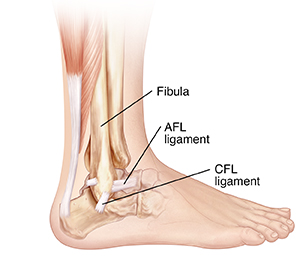Having Lateral Ankle Ligament Reconstruction
Lateral ankle ligament reconstruction is a surgery to tighten and firm up one or more ligaments on the outside of the ankle. It’s also known as the Brostrom procedure. It’s most often done as an outpatient surgery. This means you can go home the same day.
What to tell your healthcare provider
Tell your healthcare provider about all the medicines you take. This includes over-the-counter medicines such as ibuprofen and aspirin. It also includes vitamins, herbs, other supplements, and any illegal drugs. Also tell your healthcare provider if you:
-
Have had any recent health conditions or changes in your health, such as an infection or fever
-
Are sensitive or allergic to any medicines, latex, tape, or anesthesia (local and general)
-
Are pregnant or think you may be pregnant
Tests before your surgery
Before your surgery, you may need imaging tests. These may include X-rays or MRI.
Getting ready for your surgery
Your procedure will be done by an orthopedic surgeon. This is a healthcare provider who specializes in surgery of bones, ligaments, and tendons. Talk with your surgeon about how to get ready for your surgery. You may need to stop taking some medicines before the procedure, such as blood thinners and aspirin. If you smoke, you should stop before your surgery. Smoking can delay healing. Talk with your surgeon if you need help to stop smoking.
Write down all of your questions about the surgery and make certain they are answered. Questions may include such things as:
-
What are the most serious and the most frequent complications of this surgery?
-
What are the risks if I do not have surgery?
-
How much pain can I expect? How will it be controlled in the hospital and after I go home?
-
Will I be able to contact you after the surgery if I have a question or problem?
Also, make sure to:
-
Ask a family member or friend to take you home from the hospital.
-
Plan some changes at home to help you recover. You won’t be able to walk on your foot normally for a while. You may need help at home.
-
Follow any directions you are given for not eating or drinking before surgery.
-
Follow all other instructions from your healthcare provider and surgical staff.
You will be asked to sign a consent form that gives your permission to do the procedure. Read the form carefully. Ask questions if something is not clear.
On the day of your surgery
Your surgeon will work with a team of specialized nurses. The surgery can be done in several ways. Ask your healthcare provider about the details of your surgery. The whole procedure may take 2 or more hours. In general, you can expect the following:
-
You will have general or regional anesthesia, a medicine that allows you to sleep through the surgery. You won’t feel any pain during the surgery.
-
A healthcare provider will watch your vital signs, like your heart rate and blood pressure, during the surgery.
-
After cleaning the ankle, the surgeon will make a cut through the skin and muscle of the ankle.
-
If your surgery is minimally invasive, your surgeon will make a small incision. They will put small tools and a tiny camera through the incision to do the surgery.
-
The surgeon will cut the ATFL and CFL ankle ligaments from where they attach on a bone of the lower leg (fibula). These ligaments may be made shorter.
-
The surgeon reattaches the ligaments to the fibula, using small new holes drilled into the bone or special suture anchors.
-
The surgeon makes other repairs as needed.
-
The surgeon closes the layers of skin and muscle around your ankle with stitches (sutures), staples, or both. They put a bandage over the incision.

After your surgery
After the procedure, you will spend several hours in a recovery room. Your healthcare team will watch your vital signs, such as your heart rate and breathing. You’ll be given pain medicine if you need it. Your ankle may be in a splint. You may be able to go home the same day. You will need to have someone drive you home.
Recovering at home
You will have some pain for a while after your surgery, especially for the first few days. You can take pain medicine to help relieve your pain. Follow all instructions about medicines and wound care. Keep your leg raised as often as possible. This can help reduce swelling and pain. You’ll likely need to use crutches and keep weight off your ankle for a few weeks.
Follow-up care
You will need to have your stitches or staples removed about 10 to 14 days after surgery. Your surgeon may replace your splint with a cast or boot at this time. In a few weeks, the cast may be replaced with a removable brace or boot. You’ll need to use this brace or boot for several months.
Your surgeon will give you instructions about how to strengthen your ankle and leg muscles as you recover. You may have physical therapy. This will help you regain strength and flexibility. For the best chance of recovery, follow your surgeon's advice on which daily activities you can do and which you should not.
When to call your healthcare provider
Call your healthcare provider right away if you have any of these:
-
Fever of 100.4°F (38.0°C) or higher, or as directed by your healthcare provider
-
Shaking chills
-
Redness, pain, bleeding, or swelling of the incision that gets worse
-
Fluid leaking from the incision
-
Incision that opens
-
A foot or toes that are pale, blue, or cool to touch
-
Swelling in the foot, ankle, or calf that is not helped by raising the foot